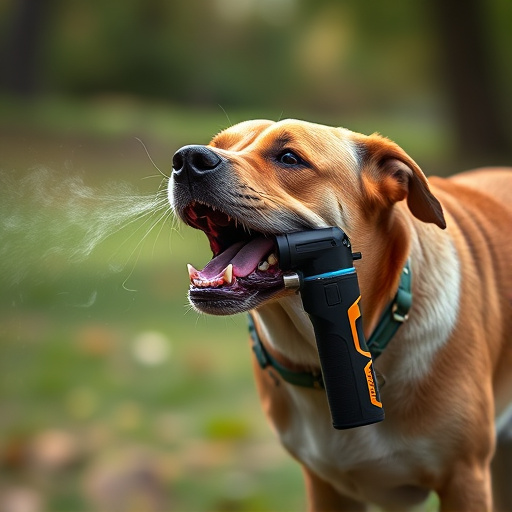Pepper spray, featuring capsaicin as its key ingredient, is a popular and effective tool for personal safety and managing aggressive dog behavior. Its formulation blends capsaicin oil, water, and additives to temporarily disorient dogs by irritating their sensitive areas, like eyes and nose. This method promotes outdoor safety when facing aggressive canines, but must be used responsibly as a last resort. Effective formulations balance potency with safety, considering regional regulations. Proper application techniques, including targeted short bursts from 6-8 inches away, and protective gear, are essential. Training through positive reinforcement conditions pets to associate the spray's scent and sound with rewards, enhancing its effectiveness during interactions with aggressive dogs.
Discover the power of pepper spray as a safe and effective solution for deterring aggressive dogs. This comprehensive guide explores the best formula for dog deterrent spray, focusing on key ingredients that work, legal considerations, and expert application techniques. Learn how to create a potent yet safe formulation, train your pet responsibly, and navigate potential challenges with confidence. Unlock the secrets to keeping both you and your furry friend secure.
- Understanding Pepper Spray for Dog Deterrence
- Key Ingredients and Their Effectiveness
- Creating a Safe and Legal Formula
- Application Techniques and Training Tips
Understanding Pepper Spray for Dog Deterrence
Pepper spray, a potent chemical compound, has emerged as a popular and effective dog deterrent option for both personal safety and managing aggressive canine behavior. Its primary active ingredient is capsaicin, the same compound responsible for the heat sensation in chili peppers. When used appropriately, pepper spray can create an immediate and powerful barrier against dogs, allowing individuals to maintain control and safety during encounters with potentially dangerous animals.
The formula of pepper spray designed for dog deterrence is specifically tailored to address aggressive behavior without causing long-term harm. It typically includes a blend of capsaicin oil, water, and other additives to enhance its stability and effectiveness. This formulation ensures that the spray irritates the dog’s eyes, nose, and respiratory tract, temporarily disorienting them and inducing an instinctive retreat response. With proper usage techniques and training, individuals can use pepper spray as a last resort when facing aggressive dogs, promoting safety in various outdoor settings.
Key Ingredients and Their Effectiveness
When it comes to creating an effective dog deterrent spray, understanding the key ingredients and their roles is paramount. A successful pepper spray formulation against aggressive dogs should include a blend of capsaicin, a natural compound derived from chili peppers, and other carefully selected agents. Capsaicin acts as a sensory irritant, triggering pain receptors in the nose and eyes when inhaled by the dog, thus creating an unpleasant experience that discourages aggressive behavior.
The formula’s potency lies in the precise balance of capsaicin and additional ingredients like citric acid and natural essential oils. Citric acid enhances the spray’s penetration, ensuring it reaches deep into a dog’s nasal passages for maximum impact. Essential oils not only add a distinct scent but also possess anti-inflammatory properties, which can help soothe any irritation caused by the pepper spray after use. This strategic combination of ingredients makes for a powerful yet safe deterrent, designed to deter aggressive canine behavior without causing lasting harm.
Creating a Safe and Legal Formula
Creating a safe and legal pepper spray formulation against aggressive dogs is paramount to ensure both effectiveness and user safety. The key lies in balancing potent ingredients that deter canine aggression with mitigating factors that prevent harm to the dog’s health and well-being. This involves meticulous consideration of capsaicin, the active ingredient responsible for the burning sensation associated with peppers, as well as additives like water, oils, and stabilizers. Each component must be carefully measured and mixed to create a spray that disrupts a dog’s sense of smell and taste without causing permanent damage or severe discomfort.
Legal constraints further complicate formulation. Different regions have distinct regulations regarding the use and content of pepper sprays, especially those intended for animal deterrence. Manufacturers must adhere to these guidelines to ensure their products remain legal and effective. This includes complying with labeling requirements, ensuring proper packaging, and meeting safety standards. By doing so, users can confidently deploy the spray when faced with aggressive dog encounters while staying within the boundaries of the law.
Application Techniques and Training Tips
Application Techniques and Training Tips
When using a pepper spray formulation against aggressive dogs, proper application technique is key. Aim for the eyes and nose—these areas are highly sensitive and will trigger a strong reaction. Hold the can upright and at a safe distance, about 6-8 inches away from the dog’s face. Spray in short bursts to avoid excessive usage, as it can be dangerous not just for the targeted dog but also for other animals or humans nearby. Always remember to keep your own safety in mind and wear protective gear if necessary.
Training is another critical aspect of effective use. Teach pets and their owners about the spray’s purpose through positive reinforcement methods. Start by conditioning pets to associate the sound and scent of the can with a treat or praise, gradually moving towards actual application. It’s essential to ensure that both pets and owners understand that the spray is not punitive but rather a tool for safety when facing aggressive behavior. Regular practice sessions will help in refining these skills, making interactions with potentially dangerous dogs safer for everyone involved.
When it comes to creating an effective pepper spray formulation against aggressive dogs, understanding key ingredients and their interactions is crucial. By combining active agents like capsaicin with appropriate diluents and stabilizers, you can develop a safe, legal, and potent deterrent. Proper application techniques, coupled with training tips for both pets and owners, ensure maximum effectiveness in calming and preventing unwanted behaviors. Remember, responsible use of pepper spray for dog deterrence requires knowledge, preparation, and a commitment to animal welfare.
